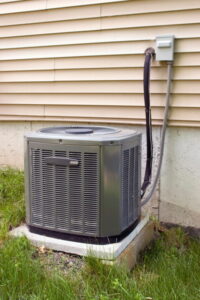Air conditioners create condensation. Just like droplets drawn from hot humid air onto the surface of an ice-cold glass, condensation forms from moisture in the air against the ice-cold evaporator coils of your AC unit. The drainage system that allows this moisture to be safely collected rather than causing puddles and water damage is a very important part of your air conditioner. It’s a huge bother when your AC unit’s drainage system isn’t working properly! Let’s get to the bottom of your drainage problem.
How Your Air Conditioner Drains Moisture
Since it’s the evaporator coils, part of the indoor unit, which cause condensation to form, this is where we’ll begin our tour of the drainage system. The water drips from the evaporator coils, landing in the condensate pan below. This pan has a drain that leads to a drainage line, usually made of white PVC or of copper. Some AC units, especially those that have the indoor unit in the basement, have a condensate pump which helps to push the water through that drainage line. Others simply use gravity to allow the water to drain. The end of the drainage line is near the outdoor unit of the air conditioner, and water drips out there. If there simply isn’t a drop of water coming out of it even when your AC unit is running, there’s a problem somewhere in that drainage system.
Causes of Drainage Problems
- Disconnection: If something has come undone, and your drain line is disconnected from the condensate pan or at any other point, water will stop dripping out the end of the drain line outdoors. This doesn’t mean there’s no water. It means it’s dripping out somewhere else! You need repairs before you end up with water damage.
- Clogs: The drain in the bottom of the condensate pan, or some other point within the drain line, may have become clogged. This clog could be made of dust and pet hair from inside your home, or it could be that mold or algae have started to grow in all that moisture! You’ll need a professional to clean it out.
- Corrosion: The weakest point in this system is where the drain line meets the condensate pan. If this connection becomes rusty, leakage can occur at that point. A little new hardware can generally resolve this problem, but you must address it promptly, because a leak—especially of red, rusty water—is no joke.
- Pump Failure: If your air conditioner does have a condensate pump, and this mechanism fails, it will be unable to push the moisture out the drain line. Again, the water has got to go somewhere, and it could be ending up somewhere that you really don’t want it to be!
Avoiding the Problem in the Future
The best way to reduce the risk of this sort of issue befalling you in the future is to make sure you get annual AC maintenance every year. One of the key tasks the technician will perform is cleaning and inspecting the drainage system. Any problems can be caught early, and mold is much less likely to grow in a freshly-cleaned condensate pan.
If you have a problem with your AC drainage, or you have any other questions about your outdoor AC unit in Cedar Grove, NJ, don’t hesitate to reach out.
Contact MarGo Plumbing Heating Cooling Inc. today for more information about your air conditioner’s drainage system!

